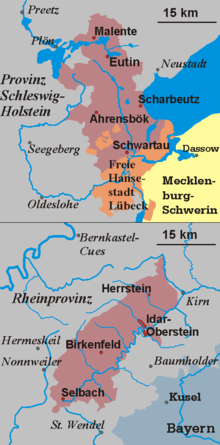Prince-Bishopric of Lübeck
This article relies largely or entirely on a single source. (May 2022) |
Prince-Bishopric of Lübeck Hochstift Lübeck (German) | |||||||||
|---|---|---|---|---|---|---|---|---|---|
| 1180–1803 | |||||||||
Protestant Reformation | 1535 | ||||||||
| 1803 | |||||||||
| |||||||||
The Prince-Bishopric of Lübeck, (
The Prince-Bishopric of Lübeck, a secular state, should not be confused with the Diocese of Lübeck, which was larger and over which the bishop exercised only pastoral authority.
History

The original diocese was founded about 970 by
After the
Principality and Region of Lübeck
With the

Following the Austro-Prussian War in 1867 the principality was enlarged by the prior Holsteinian bailiwick of Ahrensbök, as a compensation for hereditary claims of the ducal House of Oldenburg to Holstein. After Oldenburg became a republic in 1918 the area remained an exclave of the Free State of Oldenburg now named Region of Lübeck (German: Landesteil Lübeck).

In 1937 the region was incorporated into the Prussian Province of Schleswig-Holstein by a territorial redeployment according to the Greater Hamburg Act. The Region of Lübeck then became the District of Eutin, which was merged with the neighbouring District of Oldenburg in Holstein in the new district of Eastern Holstein in 1970.
The Lutheran Church, since the
Geography
The state had an area of 541 km2 (209 sq mi); as the imperial city of Lübeck was not incorporated, its only city was Eutin.
Bishops of Oldenburg and Lübeck
Notes
- ^ One German sq. mile (Quadratmeile) = 21.25 Eng. sq. miles or 55.05 km2.
References


